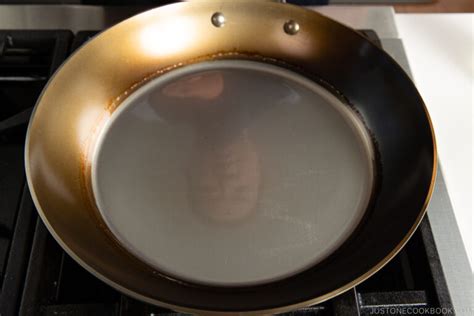Fix Your Carbon Steel Pan: A Simple Re-Seasoning Tutorial
Carbon steel pans, with their exceptional heat retention and responsiveness, are a cook's dream. But their beauty comes with a bit of maintenance: the need for proper seasoning. If your carbon steel pan is sticking, losing its non-stick properties, or looking a little rough around the edges, don't despair! This simple re-seasoning tutorial will bring your pan back to its glorious, non-stick best. We'll cover everything from cleaning to the final seasoning coat, ensuring your pan is ready for years of delicious cooking.
Why is My Carbon Steel Pan Sticking?
Before we dive into the re-seasoning process, let's understand why your pan might be sticking. The most common culprits are improper cleaning, insufficient seasoning, or damage to the existing seasoning layer. Over-washing with harsh detergents or abrasive scrubbers can strip away the protective seasoning, leading to sticking. Similarly, a thin or uneven initial seasoning can also contribute to this problem.
How to Clean a Carbon Steel Pan Before Re-Seasoning
Cleaning your carbon steel pan correctly is crucial before re-seasoning. Avoid harsh detergents and abrasive scouring pads, as these can damage the existing seasoning. Instead, follow these steps:
-
Soak and Scrape: After cooking, let the pan cool slightly. Then, soak it in warm, soapy water for about 15-20 minutes to loosen any stuck-on food. Use a wooden spoon or spatula to gently scrape off any remaining food particles. Avoid metal utensils, which can scratch the pan.
-
Gentle Scrub: Use a soft sponge or nylon brush to gently scrub the pan. A little dish soap is okay, but avoid excessive scrubbing.
-
Rinse and Dry: Thoroughly rinse the pan with hot water and immediately dry it completely with a clean towel. Any remaining moisture can interfere with the re-seasoning process.
What is the Best Oil for Seasoning a Carbon Steel Pan?
Choosing the right oil is paramount for successful seasoning. High-smoke-point oils are essential, as they won't break down during the high-heat seasoning process. Popular choices include:
- Vegetable shortening: Offers a hard, durable finish.
- Lard: Provides excellent results and a rich flavor.
- Canola oil: A readily available and cost-effective option.
- Avocado oil: A healthier alternative with a high smoke point.
Avoid oils with low smoke points, such as olive oil, as they can polymerize and create a sticky residue.
Step-by-Step Re-Seasoning Process: A Comprehensive Guide
Now, let's get to the heart of the matter: the re-seasoning process. Follow these steps carefully for optimal results:
-
Preheat the Oven: Preheat your oven to 450°F (232°C).
-
Thin Coat of Oil: Apply a very thin, even layer of your chosen oil to the entire surface of the pan, including the sides and handle (if oven-safe). Use a paper towel to spread the oil evenly; you shouldn't see any pooling.
-
Oven Baking: Place the oiled pan upside down on the middle rack of your preheated oven. This allows for even heat distribution and prevents oil from pooling.
-
Baking Time: Bake for 1 hour. You might see some smoking – this is normal. After an hour, turn off the oven and let the pan cool completely inside the oven with the door slightly ajar.
-
Repeat: Repeat steps 2-4 at least two more times, or until you achieve a smooth, dark, and non-stick surface. Each layer adds to the durability of the seasoning.
How Many Times Should I Season My Carbon Steel Pan?
The number of seasoning coats needed depends on the pan's condition and your desired level of non-stick performance. While three coats are usually sufficient, some cooks prefer to apply up to five or more for a truly robust seasoning layer. The key is to build up the seasoning gradually, allowing each coat to cure fully before applying the next.
How Do I Maintain My Seasoned Carbon Steel Pan?
Once your pan is properly seasoned, maintaining its non-stick surface is relatively simple. Avoid harsh scrubbing, and always dry it thoroughly after washing. A light oiling after each use can also help preserve the seasoning.
What if My Carbon Steel Pan is Rusty?
Rust is a more serious issue. If your pan is rusty, you'll need to remove the rust before re-seasoning. Use a fine steel wool or a nylon brush to gently scrub away the rust. You may need to repeat the cleaning and re-seasoning process several times to eliminate the rust completely and restore the pan’s finish.
By following these steps, you can effectively restore your carbon steel pan to its former glory. Remember, patience and consistency are key to achieving a beautifully seasoned, non-stick surface. With proper care, your carbon steel pan will reward you with years of delicious, healthy cooking.

